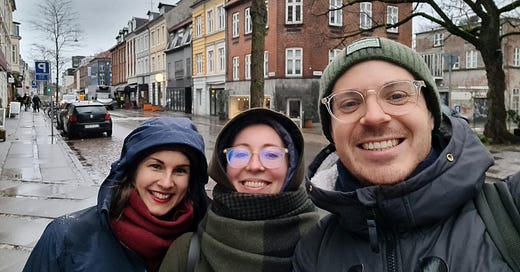Bringing democracy to urban design
An introduction from our Project Leader for Urban Design, James MacDonald-Nelson

This is the first in a series introducing members of the DemNext organization. More to come!
“Never doubt that a small group of thoughtful, committed citizens can change the world; indeed, it's the only thing that ever has.” - Margaret Mead
While I believe that, in the end, it will take many of us to truly change the world, these words have never felt more true as I become part of the small but inspiring team at DemocracyNext.
I joined the organization two months ago as Project Leader for Urban Design and Planning. Already, I have the feeling that I’ve stepped into something that offers a tangible way forward at a time when so many of us feel exhausted and disillusioned with the current system. When I pause to reflect on my own life, it makes sense to have landed here: in a movement that believes in empowering people to truly take part in making the decisions that affect their lives.
I was raised by parents who were deeply involved in the Canadian labour union movement of the 1970s, 80s and 90s. They brought me to national union conventions, labour protests, days of action, and raised me in an environment where they were fighting for the working rights of people across the country. I learned that the voices of everyday working people must be heard and that, sometimes, people in power must be challenged in order to improve workers’ rights.
As a young adult, I imagined that design was a solutions-oriented profession where I could apply these values to the worlds of architecture and the built environment. But after some 10 years in spatial practice—as a landscape architect in Toronto and Berlin and as a post-professional masters student in urbanism at TU Delft in the Netherlands—I felt, “This isn’t for me.” While from a zoomed-out view a designer’s life looks alluring, most of our work is done for private clients with private interests and rarely involves elements of public engagement or meaningful collaboration.
In Toronto, especially, this meant playing a part in the fast-paced development boom happening in the city—which was already well underway when I began working in 2015. This taught me a lot about the daily inner workings of the urban planning system, including everything that comes after a concept has been sold with highly marketable 3D renderings and buzzwords.
I began to understand the deeper bureaucratic and profit-driven reality of the planning system. Most importantly, I received a lesson in power relations: power sharing between other designers and professionals on a design team, with the city's planning department, and of course with the developer.
The missing piece in so much of my work was people. I rarely encountered genuine engagement with the people affected by our work—those who hold the least amount of power in this system and yet are the ones most impacted by new developments. Besides town hall meetings or public information about a specific project, people are rarely involved in shaping their environment or the priorities and policies that impact where and how they live.
At DemNext, my objective is to include people from all walks of life in design processes. The goal is to work with a city, a municipality, or a region that has the courage to share power and design a model of governance which provides citizens a chance to shape their environment. Although it is common for a one-off engagement process to be initiated in relation to one issue, there are often hundreds of planning decisions ongoing at any one time. We need a sustainable and systematic approach.
This means exploring some fundamental questions. What parts of the current system can be adjusted and reframed? What participatory mechanisms can be adapted to meaningfully involve people from the beginning and ensure that people have power when it comes to how their city transforms? What role do professional designers play in this kind of institutional change?
I’m excited by the opportunity to apply the values of participation, representation, and deliberation to urban planning and design. Not only am I ready to be part of making systemic change, I’m ready to tap into that part of me which stood alongside my parents at picket lines as a child and now understands the weight of collective action. That animates me and gives me faith that what we are doing as an organisation is, as adrienne maree brown says, ‘Getting into the right relationship with change.’




